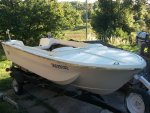Arawak
Chief Petty Officer
- Joined
- Aug 27, 2010
- Messages
- 486
Hi All...
I have recently acquired an 1972 Chrysler Charger 118 "hydro-vee" 14' runabout, for the purposes of making it into a fishing boat:

My thought is to turn it into a centre console with the batteries and fuel tank mount below the sole with a view to an uncluttered boat. This will be a complete grind down to the bare hull and rebuild. This boat will be used for fishing small local lakes, large river systems (St Lawrence), and the Great Lakes (when the weather is right and and not terribly far from shore). Something like this:

Looking for advice on a few points.
1. These hulls are apparently filled with foam below the sole, and have no stringers. Should I just refill with closed cell foam (after installing my battery boxes, conduits, and fuel tank mount), or should I consider putting in stringers? My primary concern is that the foam may absorb water. I'd like to add foam, but on a bed of 2" blue styrofoam which from experience I know will not hold water. Not sure how structural this would be or if the original foam was structural in any way.
2. Should I paint the inside of the hull with epoxy (possibly thinned with acetone) to seal the polyester? My last rebuild slowly leaked water into the sealed air cavity I built between the sole and the hull.
3. Do I need a bilge running the length of the boat? It looks like these hulls have only a small bilge in the stern and most of the hull is sealed and filled with foam. Perhaps I could make a bilge out of conduit to allow the battery boxes and the box for the fuel tank to drain into the back.
4. Most of the folks who have done these runabout to centre console conversions seem to have re-used the cap and bonded exterior plywood under it to add stiffness. Is there a good reason to do this? It seems to me that it would be easier/cleaner/stronger to laminate a thin gunwale on the inside, and build a cap out of okume plywood that rests on this. I'd just need a thin layer of cloth, compared with a couple thick layers to prevent fir plywood checking.
Thanks in advance!
I have recently acquired an 1972 Chrysler Charger 118 "hydro-vee" 14' runabout, for the purposes of making it into a fishing boat:

My thought is to turn it into a centre console with the batteries and fuel tank mount below the sole with a view to an uncluttered boat. This will be a complete grind down to the bare hull and rebuild. This boat will be used for fishing small local lakes, large river systems (St Lawrence), and the Great Lakes (when the weather is right and and not terribly far from shore). Something like this:

Looking for advice on a few points.
1. These hulls are apparently filled with foam below the sole, and have no stringers. Should I just refill with closed cell foam (after installing my battery boxes, conduits, and fuel tank mount), or should I consider putting in stringers? My primary concern is that the foam may absorb water. I'd like to add foam, but on a bed of 2" blue styrofoam which from experience I know will not hold water. Not sure how structural this would be or if the original foam was structural in any way.
2. Should I paint the inside of the hull with epoxy (possibly thinned with acetone) to seal the polyester? My last rebuild slowly leaked water into the sealed air cavity I built between the sole and the hull.
3. Do I need a bilge running the length of the boat? It looks like these hulls have only a small bilge in the stern and most of the hull is sealed and filled with foam. Perhaps I could make a bilge out of conduit to allow the battery boxes and the box for the fuel tank to drain into the back.
4. Most of the folks who have done these runabout to centre console conversions seem to have re-used the cap and bonded exterior plywood under it to add stiffness. Is there a good reason to do this? It seems to me that it would be easier/cleaner/stronger to laminate a thin gunwale on the inside, and build a cap out of okume plywood that rests on this. I'd just need a thin layer of cloth, compared with a couple thick layers to prevent fir plywood checking.
Thanks in advance!
Attachments
Last edited:



























